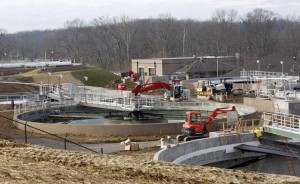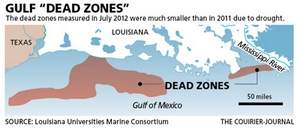Apr. 19, 2013 |
MSD is expanding capacity of its Floyds Fork treatment plant, improving its ability to remove nutrients from wastewater. MSD officials will be giving a multi-state and federal task force a tour of the construction on Friday. This photo is from 2012. JOHN SOMMERS/SPECIAL TO THE COURIER-JOURNAL.
Written by
The Courier-Journal
Nutrient pollution comes from farm and lawn fertilizer, pet and livestock waste, runoff from roads and houses, faulty septic systems, and treated sewage. It turn waters green with algae, contaminate drinking water, pollute waters for swimming and fishing and contribute to the Gulf of Mexico dead zone.
Kentucky’s top environmental regulator on Thursday said his agency was drafting a statewide plan to control pollution that causes algae blooms around the state and contributes to an oxygen-depleted “dead zone” as far away as the Gulf of Mexico.
Called a “nutrient management plan” because it would target nitrogen and phosphorous, Energy and Environment Cabinet Secretary Len Peters said a draft could be made public in late spring or summer.
“Our approach is to reduce nutrient (pollution) to all waters,” he told members of a multi-state and federal task force meeting at the Galt House this week. “We will build on our existing framework,” he added.
Peters said officials would “move forward in a rational manner … so that our economy is not harmed.”
Peters said nutrients have impaired about 350 water bodies in Kentucky and are the second-leading cause of water-quality impairment in the state.
The Mississippi River Gulf of Mexico Watershed Nutrient Task Force, comprised of 12 states, several federal agencies and tribal representatives, seeks to reduce a dead zone as large as Massachusetts in some years, fed by excessive nutrients.
States that drain into the Mississippi River have been found to contribute to the problem, largely from farm runoff but also from city stormwater and industrial and wastewater treatment plants.
The dead zone forms each spring and summer off the coast of Louisiana and Texas, threatening valuable commercial and recreational Gulf fisheries. Last year it was relatively small, because drought curbed runoff in the Mississippi basin.
The EPA has called on states to develop nutrient management plans, and as Kentucky develops its plan, officials will consult with various groups and industries, including agriculture, before making a draft public, said R. Bruce Scott, commissioner of the Kentucky Department for Environmental Protection.
He said it’s too soon to say how the plan might affect pollution sources.
“We’re confident our current approaches are working to some degree,” Peter Goodmann, the state’s Division of Water assistant director, told task force members during an afternoon presentation.
That includes working through the state’s Agriculture Water Quality Authority, which already requires farms larger than 10 acres to adopt “best management practices” to reduce pollution runoff, he said.
Goodmann said he didn’t know how much it would cost but said finding funding is as important as establishing partnerships and having good communication.
Iowa Agriculture Secretary Bill Northey said his state is looking at a potential cost of $4 billion to meet its agricultural nutrient reduction goals in that leading farm state.
“We haven’t got the dollars to show how we can get half way there yet,” he said.
Kentucky Agriculture Commissioner James Comer attended the meeting and said during a break that he only learned about Kentucky’s proposed plan the day before. Asked if he was concerned about how it might affect farmers, he said: “I am always concerned.”
He said he would follow the process closely to make sure there are “no unintended consequences” on farmers.
In a related matter, Comer told the task force that the state’s Agriculture Development Board is working with the U.S. Geological Survey to identify the sources of nutrient pollution in Christian County and also hopes to do the same in the Floyds Fork watershed locally.
“If it’s coming from us, we want to know, so we can fix it,” Comer said of farmers.
Goodmann said the state’s thinking is to focus on key watersheds where significant improvements can be achieved.
He said the state has done well to bring treated drinking water to 95 percent of the state’s residents, but most Kentuckians don’t have access to municipal sewage treatment and are on less reliable septic tanks.
“We have huge infrastructure problems in this state,” Goodmann said.
Kentucky, with Indiana and Ohio, is also experimenting with water pollution trading. That’s where farmers could earn credits for taking steps to reduce their nutrient runoff and then sell those credits to industrial sources, which could then avoid some pollution controls at their facilities.
“It is a very good tool that is showing a lot of progress,” said Jessica Fox, a scientist with the Electric Power Research Institute, which is helping to establish a pilot trading program with the three states.
Brad Klein, an attorney with the Environmental Law and Policy Center in Chicago, told the task force that pollution trading can be a useful tool if it’s done in a way that doesn’t allow pollution hot spots.
But environmental advocates pressed task force members and Kentucky to adopt numerical standards for the two nutrients instead of relying only on narrative descriptions of water quality goals.
“Narrative standards are too open to interpretation,” said Tim Joice, water policy director for the Kentucky Waterways Alliance, which is part of a coalition that has sued the EPA to establish numerical nutrient limits in Mississippi Basin waterways.
In Goodmann’s presentation, he had said statewide numerical standards don’t work well because of differences between watersheds.
“We think it’s very difficult to tease out scientifically and defensible bright-line thresholds.” Goodmann said.
This week’s meeting marks the first time the task force has met in Kentucky, which joined the group in 2010. It’s also the first time the task force has met in a state along the Ohio River.


